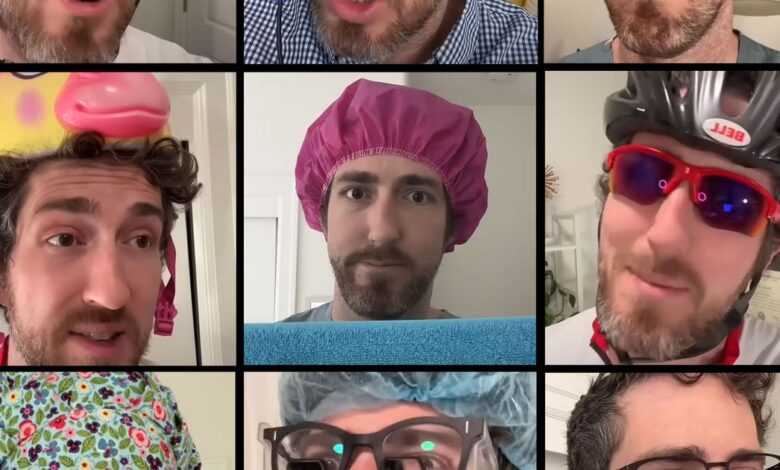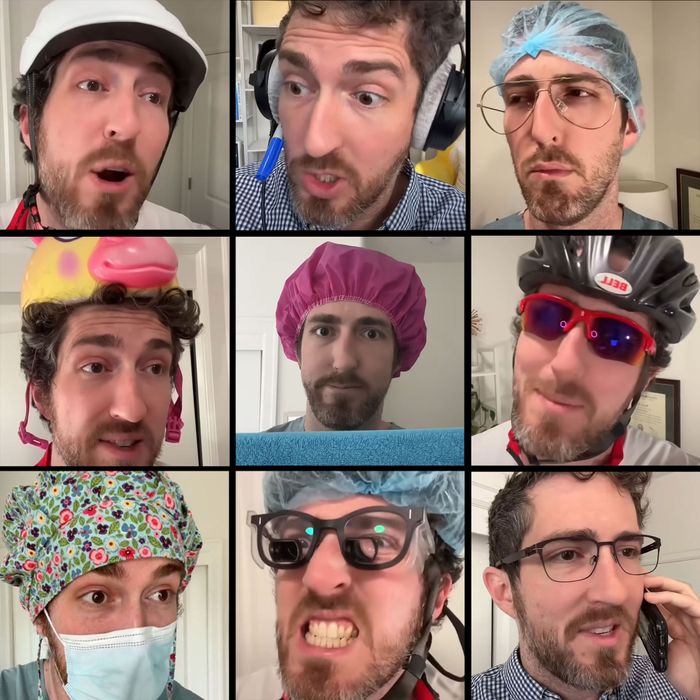

Illustration: New York Magazine; Photos: Dr. Glaucomflecken/TikTok
There are no medical degrees hanging on the white walls of ophthalmologist Will Flanary’s home office. There is, however, a golden plaque on display that YouTube sent him when he surpassed 1 million subscribers. “I challenge you to find a doctor who hasn’t seen my content,” he says from the opposite corner of the L-shaped couch in the open-concept living room of his home in Wilsonville, a suburb about 30 minutes south of Portland, Oregon. The 38-year-old, who goes by Dr. Glaucomflecken to his more than 4 million fans across TikTok, YouTube, and X, is in jeans and a Good Man Brand gray marl button-down that he often wears in his parody videos, one of which, entitled “How to ace your neurosurgery residency interview,” has been viewed 9.5 million times on TikTok.
It’s late morning on a Monday, Flanary’s day off from his eight-to-five examining eyes, and I’ve driven 22 miles to meet an internet sensation none of my knowledge-economy friends have heard of — although when I texted an anesthesiologist friend to ask whether he knew who Dr. Glaucomflecken was, he responded immediately, “Everyone loves him!! Including me.” I also ran into a physician acquaintance at my daughter’s soccer practice, and she was delighted to learn I was writing about Dr. G. It turns out even my veterinarian neighbor is a fan.
Flanary has gone by “Glaucomflecken” (derived from “glaukomflecken,” which are flecks that arise from a rare kind of glaucoma) since he began writing for Gomerblog, a now-defunct medical Onion, while he was a medical student at Dartmouth. As a physician, he was voted one of Portland’s best doctors by Portland Monthly in 2020, and he has a Zocdoc score of 4.72 out of 5. Online, he’s known within the health-care community mainly for his dad-joke-adjacent, hyperspecific skits caricaturing different kinds of physicians. There’s the on-high-alert infectious-disease doctor who visits Pike Place Market in Seattle and asks the shucker, “Three-for-one oysters? Does that come with Vibrio, or do gram-negative rods cost extra?” (Vibrio, for those of us who did not go to medical school, is a type of rod-shaped bacteria that turns pink when subjected to something called a Gram’s stain.) The neurosurgeon character, Neuro, is so addicted to work, he mistakes the models in a stock photo for his own family. When the dermatologist goes to the beach, he won’t let his kids take off their shirts until the UV index dips below 4.2. “Did you get your ears? Elbows? Hands and feet?” he asks in the video. “How about your philtrum?”
Compared to Drs. Mike (once named People magazine’s Sexiest Doctor Alive), Pimple Popper, or Roxy (who recorded surgeries in the operating room until her license was revoked last year), Dr. Glaucomflecken is refreshingly artless — he doesn’t seem to be trying to sell anything except his ability to straddle both an expert’s mastery of medicine and an outsider’s capacity to satirize it. “I mean, if I wanted to, I could make so much money,” he tells me. “It’s so easy to turn into Dr. Oz, to just take these offers. I can understand how someone like him becomes him, because there’s a lot of shady shit out there.”
Flanary’s four-bedroom home does not scream influencer money or doctor money, but rather, “I graduated with $320,000 in debt.” The couch is stained, and the rug pad is poking out from under the rug. The décor is not French country or minimalist, it’s ocular: From my corner of the couch, I spy an eye-shaped mirror on the wall, a print of an elephant wearing eyeglasses, a plant with an eyeball stake stuck into it, and another plant in a ceramic pot with a face that is, of course, bespectacled.
Flanary’s wife, Kristin, quit her job as a communications manager in 2022 to help run the Glaucomflecken empire. She now goes by Lady Glaucomflecken. About an hour after I arrive, she pops into the kitchen to get something out of the cabinet, hopping onto the granite countertop to reach it while briefly introducing herself. (She’s five-foot-three; he’s six-foot-four.) The pair have a podcast called Knock Knock, Hi!; a Patreon; a newsletter called Glauc to Me; and merch, including a $20 prayer candle featuring one of Flanary’s more well-known characters, an unsettlingly intense medical scribe named Jonathan whose “body runs not on calories but on the satisfaction of a job well done.” Flanary also records Cameos starting at $249 apiece for graduating med students and retiring physicians, introducing himself as “the third-most-famous ophthalmologist on social media behind Syrian dictator Bashar al-Assad and U.S. senator from Kentucky Rand Paul.”
Eight years ago, “bored to tears at this conference,” Flanary joined Twitter. “I was telling painfully specific ophthalmology jokes to an audience of four people,” he says. (An example: “Why yes I did just watch all of Radiohead’s 90s music videos to try to figure out the etiology of Thom Yorke’s eyelid ptosis. So what?”) When the pandemic hit, he pivoted to video. In just over a month, he made nearly three dozen TikToks about such topics as blue-light-blocking glasses being b.s. and the uselessness of ophthalmologists during COVID and in-flight emergencies. “I quickly realized that if I wanted to build an audience, I had to expand to other areas of medicine,” he tells me. So he supplemented what he’d picked from his medical training — and what he was experiencing in his third year as a practicing ophthalmologist — by “getting on Reddit threads from nine years ago” and culling through the job complaints posted in a “physician side-gig Facebook group that’s got a hundred thousand physicians in it because everyone’s looking for a way out.”
In May of 2020, he had a middle-of-the-night cardiac arrest, and Kristin performed CPR on him until paramedics could arrive. He spent three days in the ICU and eventually had surgery to implant a wearable defibrillator under his skin. “We have a defibrillator now in our house,” he tells me, gesturing vaguely behind him. “They’re expensive.” Even though he had health insurance, he was left with a bill for thousands of dollars and had to navigate the hellscape of claim denials. “What we put people through in this country is unconscionable,” he says. “And, unfortunately, it’s not until it is directly affecting you that you really start to take notice. And that’s what it was like for me. I was like, ‘This is fucked up.’” Three months later, he posted a video in which he played the role of himself — Will Flanary — a dumbfounded patient treated by out-of-network doctors while unconscious, and a maddeningly stick-to-the-script insurance representative who explains that if patients would only call on the way to the hospital, their bills wouldn’t be so high. It got over 1 million likes.
These days, the bulk of Flanary’s videos — and the most popular ones — poke fun at the people providing care, not the ones profiting off of its privatization. “The feedback I always get is, ‘Oh, so this is basically the military.’ ‘This is law school,’” he says. “People will very frequently relate to their non-health-care family and friends through my videos and be like, ‘This is what it’s like.’”
His primary goal, however, is using humor to make other M.D.s feel perceived. “I’m very fortunate in ophthalmology, but it’s not easy to practice medicine in the U.S.,” he says. “Which is why I think we need more physician content creators talking about these things.” Flanary gets why there aren’t. “The reason I was anonymous initially was because I was afraid of getting fired for telling jokes as a doctor,” he says. As it turns out, his fear was unfounded. Fellow physicians who have seen his videos have, so far, all been fans. As for his patients, most don’t know who he is online — he does a lot of cataract surgeries, which are most commonly performed on people in their 70s — but every week, he gets a few who have stumbled upon his videos while doctor-shopping and even the occasional new patient who was a fan first. “Just the other day, someone wanted to take a picture with me. They made an appointment because of Glaucomflecken,” he says. He tells me that people will actually call the office asking to schedule a visit with Dr. Glaucomflecken. “Then we have to tell them, no, it’s actually Dr. Flanary.” Sometimes, in the exam room, they point to his scribe and ask, “Is that your Jonathan?”
I ask Flanary how he sees medicine and medical influencing coexisting in his ten-year plan, especially now that his wife is part of the business. “That’s a good question,” he says; then, “Can I go use the bathroom?” He disappears upstairs. When he returns, he confesses that in the early days, his extracurricular activities were a point of contention. “We certainly had our share of arguments about, ‘Hey, while you’re at home with the family, you need to not be doing this.’ Which is the danger of social media: You just get sucked into these things,” says Flanary, whose two daughters Kristin asks me not to name. “And so I think what probably helped ease that a little bit was when I did start making money off of it. I was like, ‘Well, I’m spending all this time, but we’re actually making some money.’”
He and Kristin are currently one sold-out stop into their ten-city tragicomic Wife & Death live show, during which they play the 911 call from the night of Flanary’s cardiac arrest. And Flanary just inked a deal with the 212-year-old New England Journal of Medicine to make videos teasing newly published studies. He offers to let me watch him film one, so we move to his office, where he records all his skits directly into the TikTok app. Next to his desk is a ring light and a plastic bin of props, which he rifles through to show me his grandfather’s blazer for when he plays a psychiatrist and a unicorn headband for his cartoonish pediatrician character. One wall is taken up by shelves of color-coded books, including a copy of Pre-Suasion, A Revolutionary Way to Influence and Persuade. “Most of these are Kristin’s books,” he tells me. “She reads a lot more than I do. She’s also the color person.”
He pulls up his email drafts, which is where he writes all his scripts, and clicks through until he finds the one he wants. Holding his iPhone in one hand, he tilts his chin up slightly and directs his gaze just to the left of the camera, then starts reading from his desktop monitor. “Hey, Ortho,” he begins. (Orthopedists are “the gym-rat bros,” he tells me in preparation for understanding the skit.) Then he turns to face the other direction. “Oh, what up, Bug Bro?” (This would be the infectious-disease doctor.) Bug Bro proceeds to explain the results of a new study to Ortho, who’s “busy” Googling the word “bones.” Neither can understand the other one without dumbing things down: Infectious disease has to refer to the preoperative disinfectants iodine and chlorhexidine as “Ancef lotion” (I don’t get it, but the term will elicit a barrage of laughing-crying emojis when the video is eventually posted), and Ortho resorts to translating open extremity fractures into “bone sticky outie.”
When Flanary finishes, I feel like I should laugh. Instead, I ask him who came up with the idea for the partnership with the journal. “One of their deputy editors,” he says. “I was shocked. It was like, ‘Wow,’ because you think of the big publishers as a stalwart, unable to change,” he tells me. “You would think that nobody in health care has ever heard a joke before I came along, because I get so many requests from people to take a thing in medicine and just make it funny.”




